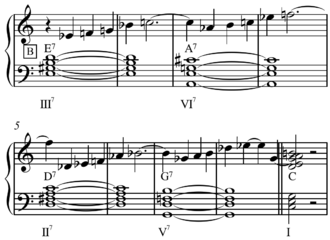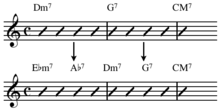- Outside (jazz)
-
This article is about the jazz technique. For the record label, see Outside Music. For the music genre, see Outsider music.
 Side-slipping complementation: C7 chord/Lydian dominant scale (chord-scale system) and complement
Side-slipping complementation: C7 chord/Lydian dominant scale (chord-scale system) and complement
 Play (help·info).
Play (help·info).In jazz improvisation, to play outside, or out, is to intentionally stray from the key or chord changes of the song form. The term refers to a soloist taking some of the harmonic liberties of free jazz within a hard bop or modal context.[1] There are various approaches to outside playing, including "free" playing, as well as the superimposition of alternate harmonic material including side-stepping[2]. However, "having essentially the same meaning, these terms [side-slipping and outside playing] refer to events in a solo where the improviser is deliberately playing 'out-of-the-key' for the sake of creating tension".[3]
Side-slipping or side-stepping (planing, parallelism) is a type of outside playing in which a soloist super-imposes a scale a half-step above or below the "inside" or standard consonant scale for the given chord or key.[2][4]
In the example on the rhythm changes B section to the right, the (heptatonic) scale for each chord would be:
E7 - E mixolydian A7 - A mixolydian D7 - D mixolydian G7 - G mixolydian C - C major
Thus the non-scale notes, in this case a pentatonic scale based on a root note one half-step down, would be:
E7 - E♭ major pentatonic A7 - A♭ major pentatonic D7 - D♭ major pentatonic G7 - G♭ major pentatonic C - C♭ major pentatonic
One technique used for sideslipping is the addition of distant ii-V relationships, such as adding a ii-V a half-step above the original ii-V. This increases chromatic tension as it first moves away and then towards the tonic.[2]
Examples of outside playing may be found in the work of John McLaughlin, Miles Davis, John Coltrane, Wayne Shorter, and Scott Henderson, among others,[5] with outside playing being characteristic of Coltrane's mature style.[6]
See also
- Bar-line shift
- Chord substitution
- Constant structure
- Parallel harmony
Sources
- ^ "Outside [out]", The New Grove Dictionary of Jazz;, 2nd Edition, Oxford University Press, 2007
- ^ a b c Lawn, Richard and Hellmer, Jeffrey L. (1996). Jazz: Theory and Practice, p.119. ISBN 0882847228. This technique [adding a ii-V a halfstep above the original] is often employed by soloists as a form of "sideslipping," or "sidestepping," which is playing chromatically outside of the chord changes.
- ^ Coker, Jerry (1991). Elements of the jazz language for the developing improvisor, p.83. ISBN 9781576238752.
- ^ Morgan, David; Edward Berger, David Cayer, Henry Martin, Dan Morgenstern (2002). Annual Review of Jazz Studies, Volume 11. Superimposition in the Improvisations of Herbie Hancock: Scarecrow Press, Inc.. pp. 79. ISBN 0810845350. "Side slipping is defined [in Liebman, David (Advance: 1991). A Chromatic Approach to Jazz Harmony and Melody, p.173.] as a 'half-step up or down movement away from what is given melodically or harmonically.'"
- ^ Fisher, Jody (1995). Complete Jazz Guitar Method, p.50. ISBN 9780739025901.
- ^ Martin, Henry and Waters, Keith (2011). Jazz: The First 100 Years, p.271. ISBN 9781439083338.
Categories:- Chromaticism
- Improvisation
- Jazz techniques
Wikimedia Foundation. 2010.


